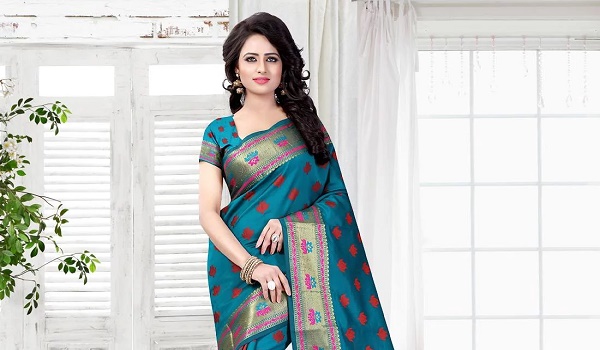
Image Credit: http://www.craftsvilla.com/womens-clothing/sarees/banarasi-sarees/
An Indian woman, clad in a Banarasi silk saree, complete with her solah sringar (16 makeup items), is the dream girl of every Indian man. There is hardly any woman in India whose wardrobe does not include Banarsi sarees. Even the trousseau of a bride is incomplete without this much-coveted possession. Benarasi Sari offers such grace to a woman that can hardly be matched by any other dress.
However, behind all this grace is a weaver, whose skill and genius goes into the making of such a splendid outfit. Usually, it takes around 15 days to one month to complete a Banarasi saree. Still, the time may vary depending upon the complexity of designs and patterns of the sari.
The Mughal era was the time when the fame and recognition of Banarsi silk sarees of India reached its pinnacle. Even the motifs underwent a change and the saree saw new designs, resulting from the combination of Indian and Persian patterns. Today, Indian craftsman are exporting Banarsi sarees, the specialty of Benaras/Varanasi, to the remotest corners of the world.
Numerous weavers, in and around the city of Benaras, are engaged in this ever-expanding industry. The silk used in the making of Indian Benarasi silk sarees is being sourced from the southern parts of the country, mainly Bangalore.
Types of Banarsi Sarees
There are following four basic varieties of Banarasi silk saree:
- Pure Silk Saree (Katan)
- Organza Saree (Kora), with Zari And Silk
- Georgette Saree
- Shattir Saree
Making of a Banarasi Silk Saree
An ideal Banarasi Sari comprises of somewhere around 5600 thread wires, all of them 45-inch wide. The base of the sari is woven on the power loom. In case of weaving the warp, the craftsmen make the base, which is around 24 to 26 m long. One of the most important aspects of weaving Banarsi silk sarees of India is the teamwork involved. Typically, three weavers are involved in the creation of the saree. One of them weaves the saree, while the second one is engaged at the revolving ring, where bundles are created.
At the time of bundling a new process of designing the motifs begins. For creating design boards, the first thing that is done by an artist comprises of sketching the design on a graph paper, along with color concepts. Before selecting the final design, punch cards are created. A single design of an Indian Benarasi saree requires hundreds of perforated cards for the implementation of the idea. Different threads and colors are used on the loom to knit the prepared perforated cards. The knit perforated cards are then paddled in a systematic manner. This is done to ensure that the main weaving picks up the right colors and pattern.




